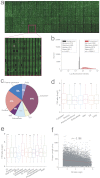Rapid identification of monospecific monoclonal antibodies using a human proteome microarray
- PMID: 22307071
- PMCID: PMC3433917
- DOI: 10.1074/mcp.O111.016253
Rapid identification of monospecific monoclonal antibodies using a human proteome microarray
Abstract
To broaden the range of tools available for proteomic research, we generated a library of 16,368 unique full-length human ORFs that are expressible as N-terminal GST-His(6) fusion proteins. Following expression in yeast, these proteins were then individually purified and used to construct a human proteome microarray. To demonstrate the usefulness of this reagent, we developed a streamlined strategy for the production of monospecific monoclonal antibodies that used immunization with live human cells and microarray-based analysis of antibody specificity as its central components. We showed that microarray-based analysis of antibody specificity can be performed efficiently using a two-dimensional pooling strategy. We also demonstrated that our immunization and selection strategies result in a large fraction of monospecific monoclonal antibodies that are both immunoblot and immunoprecipitation grade. Our data indicate that the pipeline provides a robust platform for the generation of monoclonal antibodies of exceptional specificity.
Figures




References
-
- Uhlén M., (2008) Affinity as a tool in life science. BioTechniques 44, 649–654 - PubMed
-
- Strebhardt K., Ullrich A. (2008) Paul Ehrlich's magic bullet concept: 100 years of progress. Nat. Rev. Cancer 8, 473–480 - PubMed
-
- Köhler G., Milstein C. (1975) Continuous cultures of fused cells secreting antibody of predefined specificity. Nature 256, 495–497 - PubMed
-
- Stoevesandt O., Taussig M. J. (2007) Affinity reagent resources for human proteome detection: Initiatives and perspectives. Proteomics 7, 2738–2750 - PubMed
Publication types
MeSH terms
Substances
Grants and funding
LinkOut - more resources
Full Text Sources
Other Literature Sources
Research Materials

